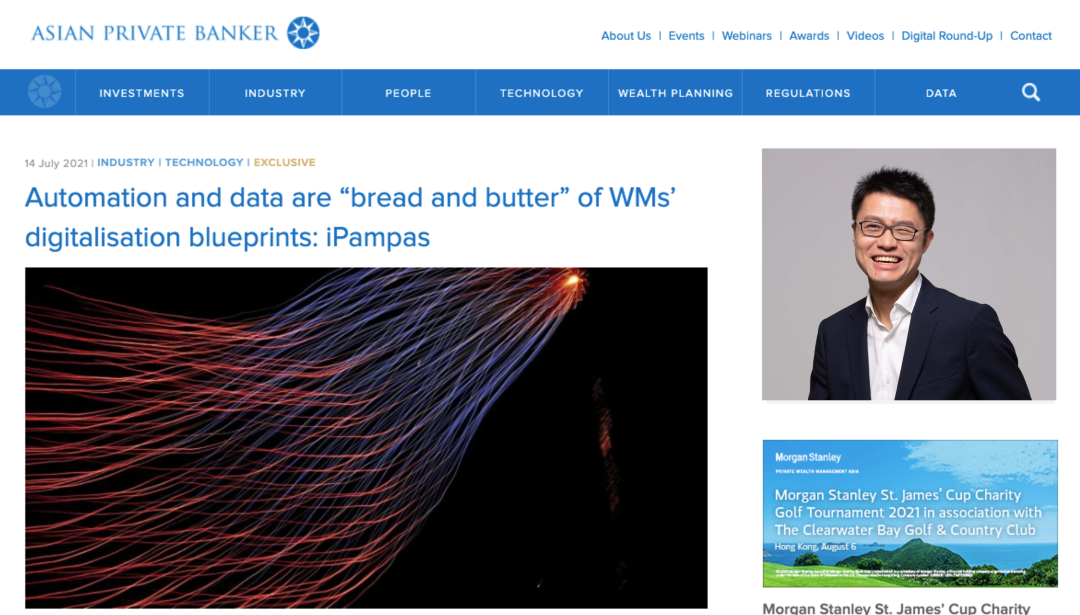海外专访 | 自动化和数据——数字化财富管理蓝
前言:
作为亚洲私人银行家Technology Awards2020年「最佳独立资产管理/ 联合家族办公室解决方案」大奖的得主,潘帕斯科技在财富管理数字化转型的赛道取得了耀眼的成绩。近期,潘帕斯「首席产品官」大澄接受了亚洲私人银行家的访谈,与行业分享了我们对数字化转型以及财富科技应用的心得体会。
本文系访谈翻译稿,阅读原文请访问「亚洲私人银行家(Asian Private Banker)」官网。
采访人:Lorretta Chen
受访人:大澄 翻译:潘之花
发布时间:2021年7月14日
https://asianprivatebanker.com/industry/automation-and-data-are-bread-and-butter-of-wms-digitalisation-blueprints-ipampas/

金融科技公司潘帕斯认为:为了部署一个成熟的人工智能驱动的解决方案,财富管理机构应该将机器人流程自动化(RPA)作为其数字化转型的第一步。对于一个拥有明显的增长轨迹并刚刚追赶上发达市场同行的行业来说,尤其如此。
「在过去的两三年中,是什么为财富管理机构创造了最大价值?是RPA(机器人流程自动化)与数据管理」,潘帕斯科技的联合创始人兼首席产品官施宏斌(花名:大澄)这样断言。
「RPA是实现行业大规模工作流自动化的最重要方式。作为人工智能的初始阶段,这是实现进一步系统协作的关键」,他这样说。
这个想法是从基础开始,RPA技术的核心是用自动化解决方案,去替代繁重的手动数据处理任务。越来越严格的监管报告规则推动了自动化的需求,以及财富机构对成本效益的要求。
自动化和数据管理不仅发生在财富管理公司的后端系统中,而且也扩展到机构运营的整个生态系统中。
大澄说:「中国财富管理公司的典型合作伙伴,包括保险公司、资产管理公司、银行和经纪公司。RPA可将来自这些不同供应商的数据,转化为标准化格式以保持其一致性,并最终为财富管理机构带来更多定制化和差异化的机会。」
「财富机构可以真正的从客户视角生成解决方案——从服务提供商那里提取数据,比较他们提供的产品,并生成一个动态的解决方案。」
跨境连接
总部位于杭州的潘帕斯科技,是为数不多的针对中国财富管理机构跨境业务的金融科技公司之一,这类业务大部分都发生在香港。潘帕斯科技为这些国内公司设计了连接国际服务提供商生态系统所需要的基础IT设施。
「中国大陆的财富机构正在寻找进入香港市场的方法,并为中国客户提供离岸服务,但他们需要某样东西,作为国际供应商生态系统与其自身结构之间的桥梁。我们就来充当这个桥梁,并帮助他们建立离岸结构。」大澄解释说。
他表示,公司的解决方案与独立资产管理公司(IAM)的需求和运营模式相吻合。
「这些财富机构必须与多家银行、主经纪商和其他服务提供商打交道,每家银行都在非常不同的系统上运行并生成完全不同的报表。标准化流程使得不同银行的账户能够整合成统一视图,并呈现给客户。」他解释说。此外,RPA使得IAM能够在有限的预算内,完成自动化任务。
不过,大澄还强调,在人工智能等更先进的技术发挥作用之前,中国的财富管理机构需要确保他们的中后台设施已经准备的足够妥善,否则技术系统并不能为业务效率的提升带来实际意义。
诚然,中国的财富管理行业已经走上了与国外同行截然不同的发展轨迹。这一轨迹的一个显著特点为数字化与行业的成熟齐头并进。「中国正在同时推动这两件事。」大澄说道。
「我们正处于中间地带,中国财富管理机构依靠发达金融市场的基础设施进行离岸资产配置,」他认为,「最终,这两个市场将变得相似,但目前,它们正处在不同的阶段以不同的速度增长着。」
附英文原文
Automation and data are “bread and butter” of WMs’ digitalisation blueprints: iPampas
14 July 2021 | INDUSTRY
To deploy fully fledged AI-powered solutions, wealth managers should look no further than its precedent robotic process automation (RPA) as a first step, said Chinese fintech iPampas. This is particularly true for an industry that is just catching up to its developed market peers via a distinct growth trajectory.
“What has created the most value for wealth managers in the past two, three years was RPA and data management,” asserted Shi Hongbin, co-founder and chief product officer, iPampas.
“RPA is the most important way to realise massive workflow automation for the industry. As an initial stage of AI, it is (…) key to enabling further system collaboration,” Shi said.
The idea is to start with the basics. The core of the RPA technology is to replace burdensome manual data processing tasks with automated solutions — increasingly stringent regulatory reporting rules have been driving the need for automation together with firms’ calls for cost-efficiency.
Automation and data management not only take place within a wealth management firm’s back-end system but extend to the entire ecosystem in which the wealth manager operates.
The typical partners of a Chinese wealth manager, said Shi, include insurance firms, asset managers, banks and brokerages. RPA turns data from various providers into a standardised format to create consistency, which in the end “brings more opportunities of customisation and differentiation” for the wealth managers.
“The firm can truly generate a solution from the perspective of the customer — abstract the data from service providers, compare across their products, and generate a dynamic solution.”
Cross-border connections
The Hangzhou-based fintech is one of the few that targets Chinese wealth managers’ cross-border business — most of them in Hong Kong. It designs the infrastructure necessary for these Chinese firms to connect to the ecosystem of international service providers.
“Chinese companies are finding ways to enter the Hong Kong market to serve Chinese clients offshore, but they require something as a bridge between the ecosystem of international providers and their own structure. We act as that bridge to help them set up the offshore structure,” he explained.
Shi said the company’s solutions dovetail with the needs and operating models of independent asset managers (IAMs).
“These firms have to deal with multiple banks, prime brokers, and other service providers, each running on very different systems and generating very different statements. The standardisation process enables accounts across different banks to be integrated and presented to the client in a consolidated, uniform view,” he explained. In addition, the RPA enables IAMs to complete the automation tasks on a limited budget.
Shi emphasised that before fancier technology such as AI comes into play, wealth managers in China will need to make sure there is enough work done in the middle and back-end of their firms.
Admittedly, the industry in China has embarked on a distinct development trajectory from that of their foreign counterparts. A stark feature of this trajectory is that digitalisation goes hand in hand with the industry maturing.
“China is pushing both things at the same time,” Shi said. “We are exactly working on a middle ground, where Chinese wealth managers rely on the infrastructure of the developed financial markets for offshore asset allocation,” he opined. “In the end, these two markets will become similar, but at the moment they are growing at different rates, at different stages.”(责任编辑:admin)
